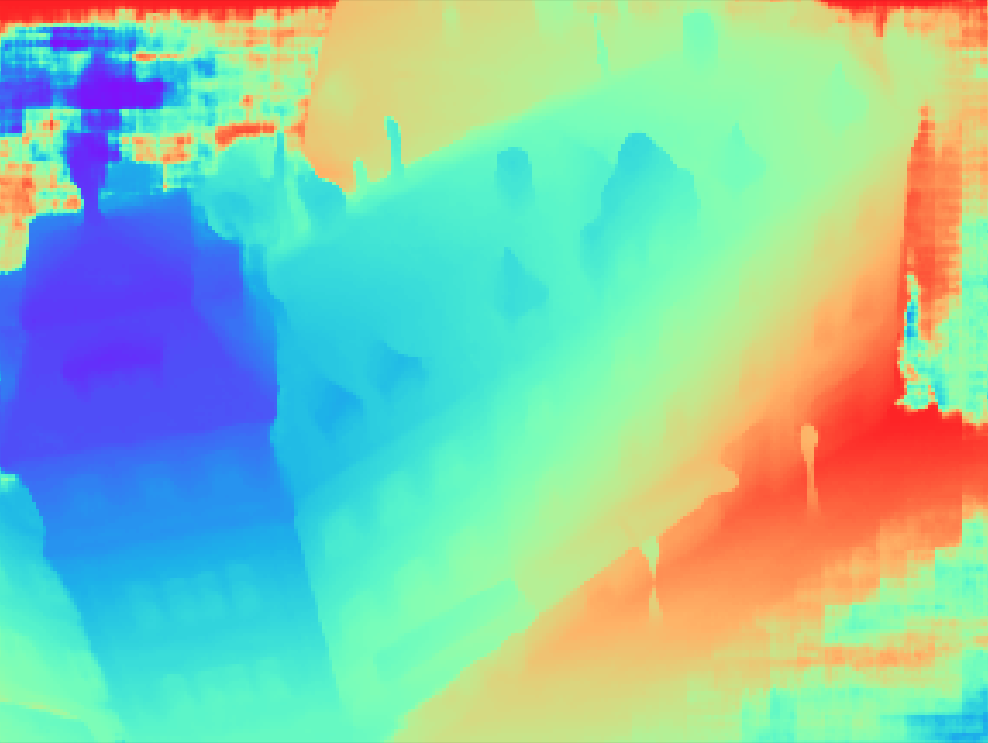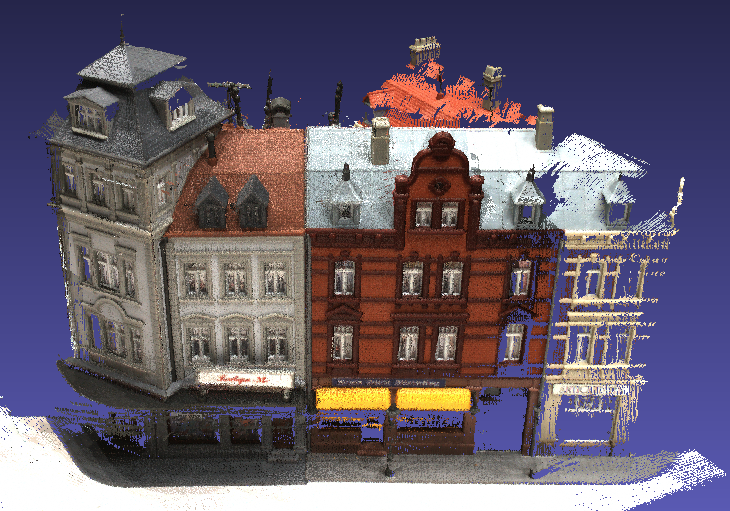MVSNet is a deep learning architecture for depth map inference from unstructured multi-view images. If you find this project useful for your research, please cite:
@article{yao2018mvsnet,
title={MVSNet: Depth Inference for Unstructured Multi-view Stereo},
author={Yao, Yao and Luo, Zixin and Li, Shiwei and Fang, Tian and Quan, Long},
journal={European Conference on Computer Vision (ECCV)},
year={2018}
}
- Check out the source code
git clone https://github.com/YoYo000/MVSNet - Install cuda 9.0, cudnn 7.0 and python 2.7
- Install Tensorflow and other dependencies by
sudo pip install -r requirements.txt
- Download the preprocessed DTU training data (Fixed training cameras, Sep. 19), and upzip it as the
MVS_TRANINGfolder. - Enter the
MVSNet/mvsnetfolder, intrain.py, setdtu_data_rootto yourMVS_TRANINGpath. - Create a log folder and a model folder in wherever you like to save the training outputs. Set the
log_dirandsave_dirintrain.pycorrespondingly. - Train the network
python train.py
- Download the test data for scan9 and unzip it as the
TEST_DATA_FOLDERfolder, which should contain onecamsfolder, oneimagesfolder and onepair.txtfile. - Download the pre-trained MVSNet model and upzip it as
MODEL_FOLDER. - Enter the
MVSNet/mvsnetfolder, intest.py, setpretrained_model_ckpt_pathtoMODEL_FOLDER/model.ckpt - Test on this dataset
python test.py --dense_folder TEST_DATA_FOLDER. - Inspect the .pfm format outputs in
TEST_DATA_FOLDER/depths_mvsnetusingpython visualize.py .pfm. For example the depth map and probability map for image00000012should look like:
 |
 |
 |
|---|---|---|
| reference image | depth map | probability map |
MVSNet itself only produces per-view depth maps. To generate the 3D point cloud, we need to apply depth map filter/fusion for post-processing. As our implementation of this part is depended on the Altizure internal library, currently we could not provide the corresponding code. Fortunately, depth map filter/fusion is a general step in MVS reconstruction, and there are similar implementations in other open-source MVS algorithms. We provide the script depthfusion.py to utilize fusibile for post-processing (thank Silvano Galliani for the excellent code!).
To run the post-processing:
- Check out the modified version fusibile
git clone https://github.com/YoYo000/fusibile - Install fusibile by
cmake .andmake, which will generate the executable atFUSIBILE_EXE_PATH - Run post-processing
python depthfusion.py --dense_folder TEST_DATA_FOLDER --fusibile_exe_path FUSIBILE_EXE_PATH - The final point cloud is stored in
TEST_DATA_FOLDER/points_mvsnet/consistencyCheck-TIME/final3d_model.ply.
We observe that the point cloud output of depthfusion.py is very similar to our own implementation. For detailed differences, please refer to MVSNet paper and Galliani's paper. The point cloud for scan9 should look like:
 |
 |
|---|---|
| point cloud result | ground truth point cloud |
Each project folder should contain the following
.
├── images
│ ├── 00000000.jpg
│ ├── 00000001.jpg
│ └── ...
├── cams
│ ├── 00000000_cam.txt
│ ├── 00000001_cam.txt
│ └── ...
└── pair.txt
If you want to apply MVSNet to your own data, please structure your data into such a folder.
All image files are stored in the images folder. We index each image using an 8 digit number starting from 00000000. The following camera and output files use the same indexes as well.
The camera parameter of one image is stored in a cam.txt file. The text file contains the camera extrinsic E = [R|t], intrinsic K and the depth range:
extrinsic
E00 E01 E02 E03
E10 E11 E12 E13
E20 E21 E22 E23
E30 E31 E32 E33
intrinsic
K00 K01 K02
K10 K11 K12
K20 K21 K22
DEPTH_MIN DEPTH_INTERVAL
Note that the depth range and depth resolution are determined by the minimum depth DEPTH_MIN, the interval between two depth samples DEPTH_INTERVAL, and also the depth sample number (max_d in the training/testing scripts). The max_d is left in the scripts for users to flexibly control the depth range. We also left the interval_scale for controlling the depth resolution. The maximum depth is then computed as:
DEPTH_MAX = DEPTH_MIN + (interval_scale * DEPTH_INTERVAL) * (max_d - 1)
We store the view selection result in the pair.txt. For each reference image, we calculate its view selection scores with each of the other views, and store the 10 best views in the pair.txt file:
TOTAL_IMAGE_NUM
IMAGE_ID0 # index of reference image 0
10 ID0 SCORE0 ID1 SCORE1 ... # 10 best source images for reference image 0
IMAGE_ID1 # index of reference image 1
10 ID0 SCORE0 ID1 SCORE1 ... # 10 best source images for reference image 1
...
The test.py script will create a depths_mvsnet folder to store the running results, including the depth maps, probability maps, scaled/cropped images and the corresponding cameras. The depth and probability maps are stored in .pfm format. We provide the python IO for pfm files in the preprocess.py script, and for the c++ IO, we refer users to the Cimg library. To inspect the pfm format results, you can simply type python visualize.py .pfm.
